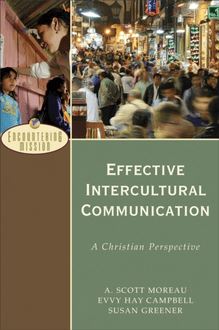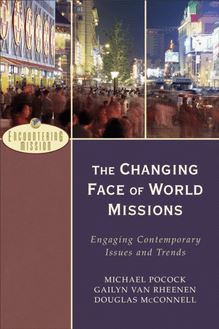Developing a Strategy for Missions (Encountering Mission) , livre ebook
227
pages
English
Ebooks
2013
Vous pourrez modifier la taille du texte de cet ouvrage
Obtenez un accès à la bibliothèque pour le consulter en ligne En savoir plus
Découvre YouScribe en t'inscrivant gratuitement
Découvre YouScribe en t'inscrivant gratuitement
227
pages
English
Ebooks
2013
Vous pourrez modifier la taille du texte de cet ouvrage
Obtenez un accès à la bibliothèque pour le consulter en ligne En savoir plus
Publié par
Date de parution
15 septembre 2013
Nombre de lectures
1
EAN13
9781441244826
Langue
English
Publié par
Date de parution
15 septembre 2013
Nombre de lectures
1
EAN13
9781441244826
Langue
English
A. Scott Moreau, series editor
Also in the series:
Introducing World Missions: A Biblical, Historical, and Practical Survey
A. Scott Moreau, Gary R. Corwin, and Gary B. McGee
The Changing Face of World Missions: Engaging Contemporary Issues and Trends
Michael Pocock, Gailyn Van Rheenen, and Douglas McConnell
Encountering Missionary Life and Work: Preparing for Intercultural Ministry
Tom Steffen and Lois McKinney Douglas
Christianity Encountering World Religions: The Practice of Mission in the Twenty-first Century
Terry Muck and Frances S. Adeney
Encountering Theology of Mission: Biblical Foundations, Historical Developments, and Contemporary Issues
Craig Ott and Stephen J. Strauss with Timothy C. Tennent
© 2013 by John Mark Terry and J. D. Payne
Published by Baker Academic
a division of Baker Publishing Group
P.O. Box 6287, Grand Rapids, MI 49516-6287
www.bakeracademic.com
Ebook edition created 2013
All rights reserved. No part of this publication may be reproduced, stored in a retrieval system, or transmitted in any form or by any means for example, electronic, photocopy, recording without the prior written permission of the publisher. The only exception is brief quotations in printed reviews.
ISBN 978-1-4412-4482-6
Library of Congress Cataloging-in-Publication Data is on file at the Library of Congress, Washington, DC.
Unless otherwise indicated, Scripture quotations are from the Holy Bible, New International Version®. NIV®. Copyright © 1973, 1978, 1984, 2011 by Biblica, Inc.™ Used by permission of Zondervan. All rights reserved worldwide. www.zondervan.com
Scripture quotations labeled ESV are from The Holy Bible, English Standard Version® (ESV®), copyright © 2001 by Crossway, a publishing ministry of Good News Publishers. Used by permission. All rights reserved.
Scripture quotations labeled KJV are from the King James Version of the Bible.
Scripture quotations labeled NASB are from the New American Standard Bible®, copyright © 1960, 1962, 1963, 1968, 1971, 1972, 1973, 1975, 1977, 1995 by The Lockman Foundation. Used by permission. www.lockman.org
Contents
Cover
Series Page
Title Page
Copyright Page
Preface
1. Strategy Defined
2. The Crafting of Mission Strategy
3. Contemporary Objections to Missionary Strategy
4. Strategic Planning in Biblical Perspective
5. Missiological Principles for Strategy Development
6. The Apostle Paul’s Missionary Strategy
7. Missions Strategy in the Early Church
8. Roman Catholic Strategy
9. Pioneer Protestant Strategies
10. Faith Missions Strategy
11. Mission Strategies on the American Frontier
12. The Indigenous Mission Strategy
13. The Church Growth Movement
14. Frontier Strategies
15. Contextualization Strategies
16. Understanding Cultural Research
17. Developing a People-Group Profile
18. Developing a Communication Strategy
19. Discerning Receptivity
20. Discerning Need
21. Visioning for the Future
22. Forming a Team
23. Assessing the Resources
24. Setting Goals
25. Choosing Appropriate Methods
26. Execution
27. Evaluation
Appendix: People-Group Profile
Bibliography
Scripture Index
Subject Index
Notes
Back Cover
Preface
M ARK ’ S C OMMENTS . . .
If you are reading this book, then you are probably serving as a missionary or preparing to serve. Though you probably are not aware of it, this makes you part of the Modern Missions Movement. William Carey, pastor of a tiny church in England, launched the Modern Missions Movement with the publication of his pamphlet “An Enquiry into the Obligations of Christians to Use Means for the Conversion of the Heathens” in 1792. He argued that Christians have a God-given responsibility to bring the gospel to the peoples of the world.
In this book we aim to continue William Carey’s work. Another book in the Encountering Mission series presents the biblical mandate for missions. In this book we focus on explaining Carey’s view of “Means.” Some believe that strategic planning is unnecessary; after all, the Holy Spirit will guide the missionaries to do what is necessary. Certainly, we believe that the Holy Spirit does guide Christians today; however, we fervently believe that the Holy Spirit can guide our planning as well as our work.
In Carey’s day some pastors rejected his pleas for the church to engage in missions. They insisted that God would bring people to salvation without human activity. Andrew Fuller, Carey’s mentor, wrote convincingly to show that God works through human instruments to accomplish his will and work in the world. Fuller and Carey persuaded most Christians in Europe and North America that God’s plan for world redemption involves human actions.
In this book we show you how to develop strategies to reach the people groups of the world for Christ. To do this, we define strategy and explain the difference between strategy and methods . From there we sketch the development of missions strategy over two thousand years of church history. Finally, we explain how you can prayerfully develop a strategy that will take you from no believers to a vibrant cluster of churches.
I am delighted that I could collaborate on this book with J. D. Payne. For many years I have taught a doctoral-level seminar on missions strategy. Some years ago, J. D. was my student in that seminar. I also had the privilege of serving on his doctoral committee. He was an excellent student, and he has become an outstanding professor, missiologist, and author. He has surpassed his professor in many ways. He is an example of why I am thankful to my doctoral students over the years. They have taught me much about missions strategy, and this book reflects their careful scholarship and edifying writing.
J. D.’s C OMMENTS . . .
In my heart this book actually began well over a decade ago. As a doctoral student, I had the privilege of being in one of Mark Terry’s seminars on world evangelization strategies. I recall him commenting on the lack of good literature on missionary strategy. Unknown to him, it was at that moment that I began to consider writing such a book. And many years later, the thought of writing a book on strategy continued to haunt me. However, I clearly could not complete a satisfactory work by myself, and there was no kindred spirit with whom I could shoulder the load other than Mark Terry. He not only has a great missiological mind, a heart for the Great Commission, a wealth of missionary experience, and has been studying and teaching strategy for many years, but he is also a great friend who has significantly influenced my life and ministry. By then, however, Mark and his wife had returned to the field as missionaries, and he was teaching at a seminary in Asia. I contacted him and shared the idea for such a book. We took almost two years to discuss, pray, and begin working on this project. This book would not have been written without the influence of Mark and his willingness to share his life with his students. That said, it is truly an honor to have worked with him on this project.
Though in the past few years a handful of books have been written on developing strategy, we have to return to 1980 (or 1990 with the revised edition) to find a comprehensive work on missionary strategy, namely, Edward R. Dayton and David A. Fraser’s massive Planning Strategies for World Evangelization. We have been greatly influenced by their work, and in this book hope to follow their leadership by attempting to provide a comprehensive work for a new generation.
While numerous matters of strategic planning today are the same as those thirty years ago, one of the topics on the minds of many in the West is the developing of missionary strategy in relation to majority world Christians. Though I began this book while serving as a seminary professor, I am now the pastor of church multiplication with The Church at Brook Hills (Birmingham, Alabama). Each year we send missionaries across the globe for short-, mid-, and long-term service. We also have partnerships with like-minded believers and churches in other countries. One topic that is on the hearts of our global disciple-making pastor and myself is: “What does healthy missions partnership look like between a church in the West and a church in the majority world?” We don’t have the definitive answer. Other churches, missionaries, and agencies are asking variations on this question today. This area of strategy development is a brave new world for many of us, and resources on the topic are few at this time. As case studies and guidelines are developed and shared broadly, Mark and I hope future authors will do a better job developing this important matter than we have done in this book.
Throughout this work we periodically draw attention to the importance of understanding and working with majority world churches on strategy development. However, even with the reality that missions today is no longer “from the West to the rest,” it is important to keep some matters in mind. First, in order to work with others on strategy development, you need to understand the foundations and mechanics of strategic planning. A failure to understand this process is likely to result in numerous unnecessary problems when working with others of different cultural backgrounds. Therefore, much of the foundational and practical components of this book are written with the Western individual and local church in mind. When doing strategic planning with a team composed of majority world believers, you will need to think through how some of the linear thought and values translate across cultural lines. Such is not an easy task in some contexts.
Second, in areas of the world where the unreached and unengaged remain, there are no majority world believers among such peoples with whom Western Christians can partner. Churches are yet to be planted. Most of this book is written with such contexts in mind, where partnerships are not possib








